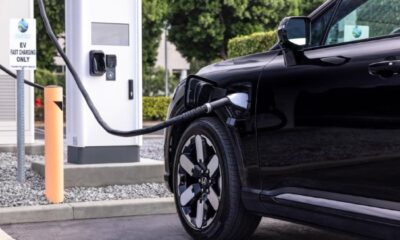Education
Lack of Power-Sharing in Northern Ireland is Making Politics More Polarised

Ordinary people in Northern Ireland are suffering the effects of ongoing governance failures. Reform of power-sharing institutions and mechanisms is needed now.
Sinn Fein’s success in 2022’s Assembly elections and last month’s local elections is undeniably historic and combined with a hardening of the Democratic Unionist Party’s (DUP) vote, the potential implications for governance and democracy in the North of Ireland are significant.
The continuing failure of stakeholders in the Good Friday Agreement (GFA) to address the decline in the effectiveness of institutions and in particular, the power-sharing Executive, has contributed towards a sharpening polarisation in the region’s politics.
In May 2022, Sinn Féin capitalised on the Unionist decline and centre-ground gains to secure a vote share of 29%, making them the largest party in the Northern Irish Assembly. This entitled Sinn Féin to nominate the First Minister of the Executive, leaving the DUP to nominate a Deputy First Minister.
Symbolism being so important in the North, these titles infer a seniority but in fact, have equal status; it was simply not contemplated that Sinn Féin might one day take First Minister. The Assembly cannot form an Executive until these roles are filled and they may only be filled by the two largest parties from the Unionist and Nationalist communities. The intention of this forced coalition was to ensure that power is shared equitably; however, it also allows one of those parties to unilaterally prevent the formation of an Executive.
While the DUP’s vote held firm, an overall shrinking of the Unionist vote is evident, with the vote tightening around the more socially conservative end of Unionist politics. It is likely that the DUP will see this as a mandate from their base for continuing rejection of the Protocol/Windsor Framework and refusal to form an Executive.
Kate Barry – PhD candidate, University of Birmingham
This May, Sinn Féin built on its success and emerged as the largest party in local government, taking 144 of the 462 available seats, with DUP remaining static with 122 seats. The election saw the continuing decline of the Ulster Unionist Party and the Social Democratic and Labour Party, the latter losing further ground to Sinn Féin and the former likely hardest hit by a swing towards the Alliance Party, now the third largest party in both Assembly and local government. The Alliance Party gained 14 seats, but only increased its vote share by 1.8% from 2019, a substantially lower gain than 2022’s 4.5%, possibly signifying a lack of impact in the absence of an Executive.
While the DUP’s vote held firm, an overall shrinking of the Unionist vote is evident, with the vote tightening around the more socially conservative end of Unionist politics. It is likely that the DUP will see this as a mandate from their base for continuing rejection of the Protocol/Windsor Framework and refusal to form an Executive.
The resulting lack of pluralism in both Unionism and Nationalism/Republicanism should be of concern. The Alliance Party, while socially progressive, is economically centre-right and (neo)liberal. Alliance’s targeting of Ulster Unionist Party, Social Democratic and Labour Party and Green Party voters in 2022 and 2023, while an electorally astute strategy, contributes to the polarisation of party politics on traditional green and orange lines. This is reinforced by Alliance’s tendency to present themselves as an alternative to ‘green and orange’: you cannot be an alternative without the status quo.
Sinn Féin’s electoral success is not as simple as an increasing mandate for a united Ireland. The political dynamics of the North are more complex. However, the outcome of this election may signal more polarised politics which leans increasingly toward the constitutional issue, in contrast to the concerns of ordinary voters who are more focussed on issues of housing, health, environment and economy. This threatens to lead to a widening disconnect between politicians and the wider public, which itself may result in increasing voter apathy and distrust in the effectiveness of political institutions.
Recent research commissioned for the Northern Ireland Affairs Committee suggests that the wider public in the North would like to see reform of the GFA institutions. The GFA and its successors have yet to deliver a long-term political and societal settlement. There is continuing resistance in Stormont to key commitments of the GFA and its successors on integrated education, the Bill of Rights, and deliberative civic forums to engage on the current and future governance of the North. Successive Executives have failed to tackle paramilitarism and related gangland violence. Legal reforms on abortion and equal marriage relied on Westminster interventions. It is highly likely that had the new Executive been formed in 2022, we would have seen abortion services in stasis without necessary funding and pregnant people continuing to travel to England to seek healthcare. As it stands, abortion services remain inadequate.
Facing a ‘cost-of-living’ crisis and potentially swingeing public sector cuts, ordinary Northern Irish people are suffering the effects of ongoing governance failures. It is essential that the Irish and UK governments work with not only Northern Irish political parties but also with civil society to start to address the failure of governance and tackle the reform of the power-sharing institutions and mechanisms. These institutions are perhaps now embedding sectarianism in a way never intended and the recent election results should serve as a warning.
Source – Birmingham
-

 Auto2 years ago
Auto2 years agoHonda Marine Debuts All-New BF350 Outboard Company’s First V8 Motor Available Commercially, Flagship Model Offers Premium Power and Unparalleled Performance for Extraordinary Boating Experiences
-

 Auto2 years ago
Auto2 years agoNew Features Further Increase Desirability Of Bentayga Range
-

 Technology2 years ago
Technology2 years agoOracle Partners with TELMEX-Triara to Become the Only Hyperscaler with Two Cloud Regions in Mexico
-

 Auto2 years ago
Auto2 years agoHonda and Acura Electric Vehicles Will Have Access to Largest EV Charging Networks in North America Aided by New Agreements with EVgo and Electrify America
-

 Lifestyle2 years ago
Lifestyle2 years ago2023 Nike World Basketball Festival Brings the Best of Basketball Style, Culture and Community














